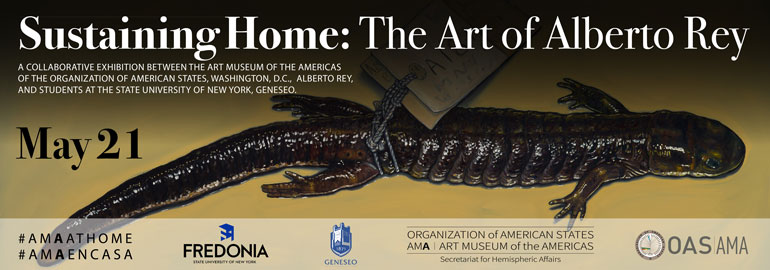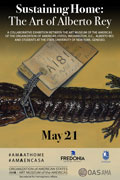
Mercedes Simpson is a senior studying Art History and Museum Studies at SUNY Geneseo. She says that working on this collaboration with the AMA and Alberto Rey has been a wonderful experience that has given her an opportunity to explore the role art plays in fostering relationships between people from many different backgrounds and disciplines. She was awarded The Pam Eder Prize for Excellence, Annual Art History Department Symposium, SUNY Geneseo (2021).
On social media May 23, 2021
Two Series—Black Lace and Binary Forms
by Mercedes Simpson
The self is multifaceted and riddled with nuance, many parts working together to create a whole. Artists like Alberto Rey use art to explore and communicate the self. One of Rey's earliest series, “Black Lace” and “Binary Forms” (1988-1992), explores religion, memory, and the convergence of separate identities. In this series, Rey used repeated images of black lace, gold, and binary shapes to create the complex surfaces of these paintings. As the series progressed, Rey employed increasingly abstract forms, pushing the boundaries of minimalist visual communication, resulting in an intriguingly mysterious and diverse series of images allusive of his subject.
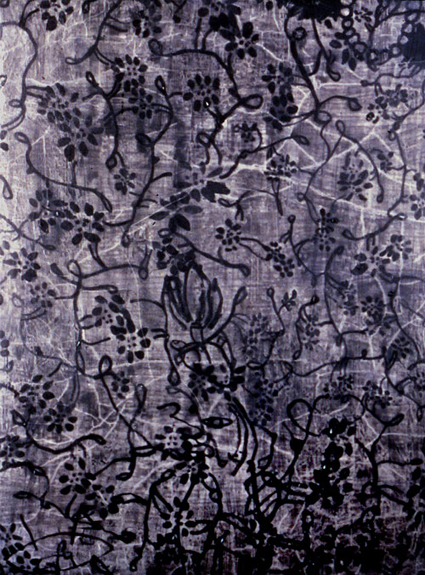
Black Lace Series: Valladolid, 1989, Oil and Ink on Flour Compound on Wood, 40 x 48”
In 1988, Alberto Rey and his future wife, Janeil Strong, traveled to Valladolid, Mexico, where bedposts carved with ferns inspired the lace pattern that he created for this project. Rey painted Valladolid, in 1989, the year he married Janeil and he began the “Black Lace Series,” inspired by his marriage. Black lace has a long history and is used to address both the virgin and seductive aspects of woman; a woman dons black lace when visiting the pope and when seducing a lover. Lace is abounds in contradiction; it is, at the same time, concealing and revealing. The minimalist abstraction, combined with suggestive form, that Rey utilized in this series is subject to that same contradiction. Hidden in Rey's hand-designed lace are abstracted, minimalist forms, which Rey uses to convey memory; most notable are Janeil’s strand of pearls in the upper right corner and her eye slightly below the center.
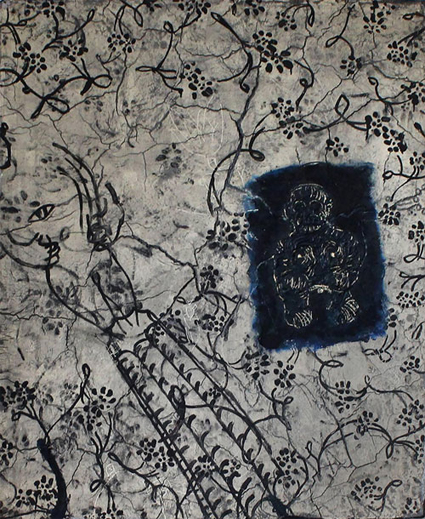
Valladolid: Fertility, 1989, Oil and Ink on Flour Compound on Wood, 40 x 48”
Black lace imagery is a recurrent theme in Alberto Rey’s “Black Lace Series” and it surfaces in Valladolid: Fertility (1989), accompanied by two feminine forms, one on a pedestal and one made of gold. In part, the use of gold found in Rey’s series Black Lace and the related series, Binary Forms, was inspired by Rey’s exposure to Santeria, the syncretic Afro-Cuban religion practiced in Latin America. In Santería, gold is representative of Oshun, the Orisha of love, fertility, and beauty. Gold has also been used as a symbol of marriage, in the form of rings, going back to the ancient Romans. In Valladolid: Fertility’s center right, there appears a floating black square, encasing a golden figure. Rey modeled this figure after a Pre-Columbian Mesoamerican pottery statuette he encountered while in Mexico. The pottery represented the form of the Aztec goddess, Tlazolteotl, shown giving birth in a squatting position. Associated with childbirth, the moon, and decomposition, Rey’s image of the goddess referenced fertility, sexuality and birth all associated with marriage.
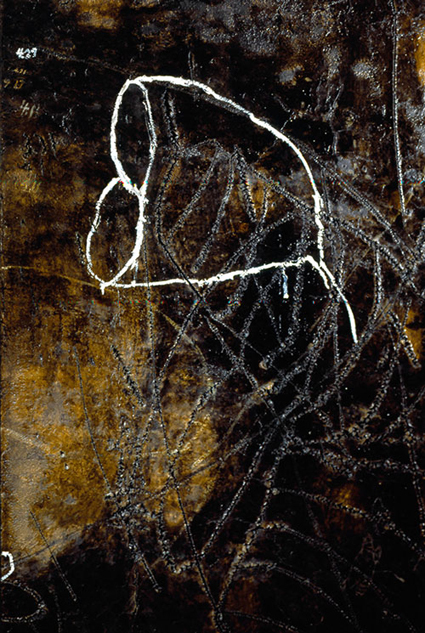
Binary Forms: Post Nuptial Gold, 1990, Oil and Ink on Flour Compound on Wood, 48 x 72”
Human beings are innately social creatures; we crave connection, acceptance, and intimacy. This need often leads us to compromise or repress parts of ourselves in order to preserve harmonious relationships. The complexity of our makeup makes it possible for us to maintain a particular fluidity of self that makes this compromise possible without affecting our core being. In his Binary Forms Series, Alberto Rey explored relationships through the use of harmonious forms, using binary shapes. In Binary Shapes: Post Nuptial Gold (1990), Rey delineated overlapping ghost-like forms to represent memories. The most prominent white binary form at the forefront overlaps many similar shapes, which here become reminiscent of an aorta, the part of the heart that supplies oxygen to the rest of the body and in this case reflects two individuals working together as one organism.
The Art Museum of the America’s Mission and Vision holds that the arts are transformative in their power of communication between communities. Alberto Rey uses art to explore transformative experiences of his life, thus shedding light on the overall human experience. The aspects of himself that Rey explored in these three paintings go beyond the artist himself, as attraction, love, and marriage are universal. The most significant art is able to transcend cultural boundaries, and Rey's minimalist approach has made his own experience resonate and accessible to a global community. As the series progressed, Rey experimented with how minimal the works could become while still creating an emotional narrative. These works are relatable in their abstraction to sensory experiences, and it is the same abstraction that generates an air of mystery, which draws the viewer deeper into a narrative, one left suggestively open. For Rey, the personal became universal as abstraction blended with realism, providing a path to realistic representation he would follow in later works.

